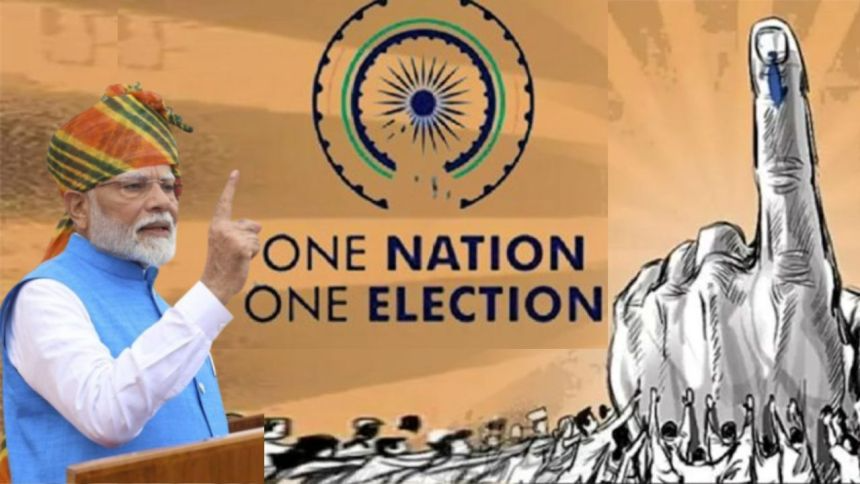One Nation One Election: Modi Government’s Vision for Electoral Overhaul
Introduction
In a bold reaffirmation of its electoral reform agenda, the Modi government has once again championed the concept of “One Nation One Election” during its third term. Prime Minister Narendra Modi, in his first Independence Day speech of this term, underscored the need for a unified electoral schedule, arguing that frequent elections create significant hurdles in the country’s progress. This ambitious promise, a key component of the BJP’s 2024 Lok Sabha election manifesto, seeks to consolidate elections for both the Lok Sabha and state assemblies into a single, synchronized cycle.
The Vision Behind One Nation, One Election
Concept Overview
“One Nation One Election” proposes that all elections in India, including those for the Lok Sabha (the lower house of Parliament), state legislative assemblies, and local bodies, be held simultaneously. Presently, Lok Sabha elections occur every five years, while state assembly elections are staggered, leading to a fragmented electoral landscape. This disjointed schedule results in continuous electoral activities, disrupting governance and administrative functions.
The Modi government’s vision aims to address these issues by synchronizing the elections, thereby reducing the frequency of polls and their associated costs. According to sources, the government is committed to realizing this promise within the next five years.
Key Objectives
The “One Nation One Election” initiative aims to:
- Cut Electoral Costs: By consolidating elections into a single cycle, the initiative seeks to reduce the extensive financial burden that frequent elections place on the government and political parties.
- Enhance Governance Efficiency: Aligning election schedules could lead to more stable governance by minimizing the interruptions caused by periodic election cycles.
- Streamline Electoral Processes: A unified electoral schedule could simplify the process, making it more efficient and less prone to logistical challenges.
- Boost Voter Turnout: With fewer elections, voter fatigue might decrease, potentially increasing participation rates.
Government Commitment and Support
Prime Minister Modi’s Advocacy
In his Independence Day speech, PM Modi strongly advocated for the “One Nation One Election” concept, reiterating his belief that frequent elections hinder the country’s progress. Modi’s push for simultaneous polls aligns with his broader agenda to streamline governance and minimize the waste of resources associated with multiple electoral processes.
Support from BJP Allies
The initiative has garnered support from BJP allies such as the Telugu Desam Party (TDP) and the Janata Dal (United) [JD(U)], reflecting a growing consensus among political factions. The commitment to this reform is further solidified by a high-level committee led by former President Ram Nath Kovind, which submitted a supportive report in March 2024.
Insights from the Kovind-led Committee
Report Findings
The Kovind-led committee on “One Nation One Election” highlighted several benefits of conducting simultaneous elections. According to the report:
- Reduction of Uncertainty: Frequent elections create an atmosphere of uncertainty, impacting policy decisions. A unified election cycle would bring greater stability and predictability to policy-making.
- Voter Convenience: Simultaneous elections would provide ease and convenience to voters, reducing the fatigue associated with multiple election rounds and potentially increasing voter turnout.
- Operational Efficiency: By conducting Lok Sabha and state assembly elections together, followed by synchronized local body polls within 100 days, the initiative aims to streamline electoral processes and reduce administrative burdens.
Arguments For and Against Simultaneous Polls
Arguments in Favor
- Cost Efficiency: Consolidating elections would reduce the costs associated with organizing and managing multiple electoral events.
- Administrative Relief: Easing the burden on administrative and security forces who are repeatedly engaged in election duties.
- Governance Focus: Allowing the government to concentrate on governance and development rather than being in a continuous election mode.
- Increased Voter Turnout: According to the Law Commission, simultaneous elections might enhance voter turnout by making it easier for people to cast multiple ballots at once.
Arguments Against
- Constitutional Amendments: Significant changes would be required, including amendments to Article 83 (Duration of Houses of Parliament) and Article 172 (Duration of State Legislatures). The constitutional amendment process is complex and requires ratification by states.
- Regional Issues: There is concern that regional issues might be overshadowed by national issues if elections are held simultaneously.
- Political Consensus: Achieving agreement among all political parties remains a substantial hurdle. Divergent views on how simultaneous elections would impact regional and national politics need to be addressed.
Global Perspectives on Simultaneous Elections
Several countries conduct simultaneous elections, providing useful insights for India. For instance:
- South Africa: Holds simultaneous elections for the National Assembly and Provincial Legislatures, with municipal elections on a separate cycle.
- Sweden: Utilizes a proportional electoral system where political parties are allocated seats based on their share of votes.
- Germany: Conducts federal and state elections concurrently, contributing to a streamlined electoral process.
These examples highlight the potential benefits and logistical considerations of implementing a unified electoral system.
Source: Money control

